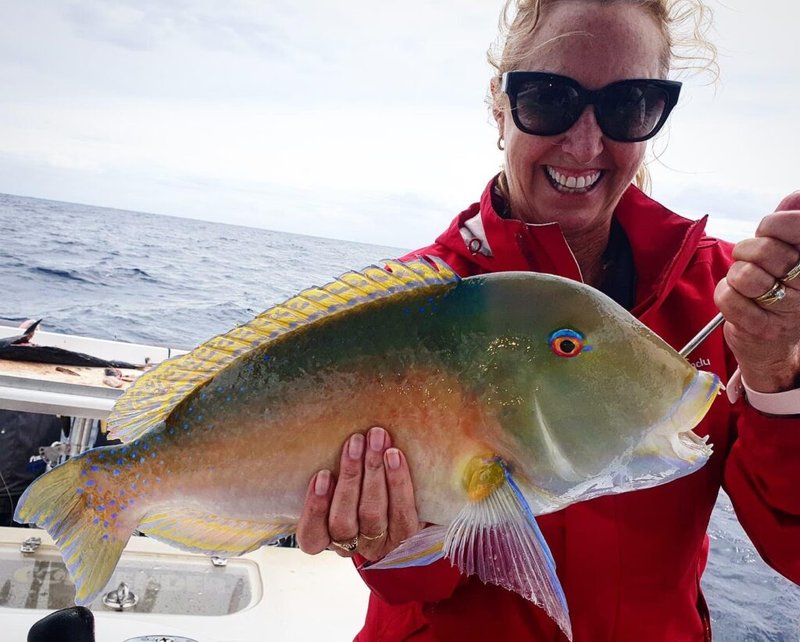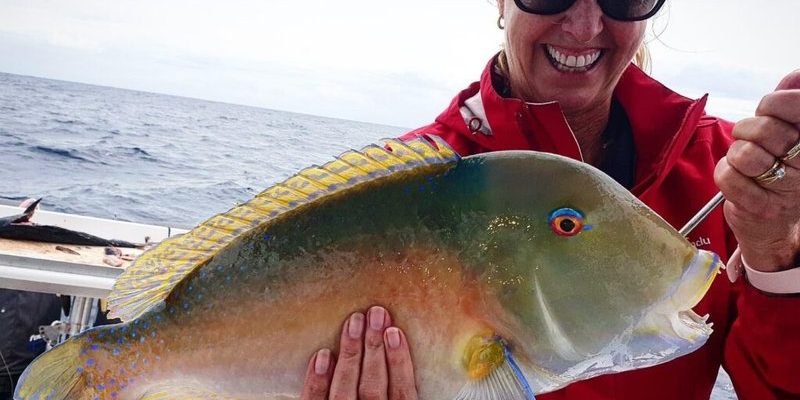
Have you ever encountered a fish that looks like it belongs in a cartoon? Meet the Tuskfish, a vibrant creature known for its striking colors and unique features. Imagine something that seems to leap from the pages of a children’s book, with its bright hues and large, tusk-like teeth. Found primarily in tropical waters, these fish are not just eye-catching; they also play a vital role in their ecosystems.
Tuskfish belong to the Choerodon genus, which includes several species varying in size and color. One of the most notable species is the Choerodon schoenleinii, also known as the blue tuskfish. These fish don’t just rely on their good looks; they also exhibit fascinating behaviors that captivate marine enthusiasts. Whether you’re a seasoned diver or just someone curious about the underwater world, the tuskfish has something to offer you.
So, what’s so special about the tuskfish? From their diet to their incredible habitats, let’s dive deeper into the life of these remarkable fish. Buckle up, because we’re going on an adventure beneath the waves!
Physical Characteristics of Tuskfish
The physical attributes of the tuskfish are among the first things that grab your attention. Their size can vary significantly, typically ranging from 12 to 24 inches in length, depending on the species. The most striking feature, of course, is their large, protruding teeth, which resemble tusks—hence the name! These powerful jaws are essential tools for the tuskfish, enabling them to crush hard-shelled prey like mollusks and crustaceans.
The coloration of the tuskfish can be quite spectacular. Take the blue tuskfish, for instance; it displays bright blue and green scales that shimmer in the sunlight. Other species may flaunt combinations of yellow, orange, and deeper blues. This vibrant pigment isn’t just for show; it helps them blend into the coral reefs where they live, offering some protection from predators.
But it’s not just about color and size; the tuskfish is also built for agility. Their streamlined bodies allow them to dart swiftly through the coral formations, dodging potential threats while also hunting for food. This combination of physical features makes the tuskfish a remarkable example of evolution in action.
Habitat and Distribution
Tuskfish are primarily found in warm, tropical waters. They’re often spotted around coral reefs, rocky outcrops, and even sandy bottoms. The most common regions to find them include the Great Barrier Reef in Australia and various islands in the Pacific and Indian Oceans. Their preference for shallow waters means they thrive in environments where there’s plenty of food and shelter.
These fish tend to be quite territorial, often staking out a specific area within their habitat. They establish their dominance over smaller fish by showcasing their vibrant colors and aggressive behaviors. The coral reefs provide both a hunting ground and a sanctuary, allowing tuskfish to hide from larger predators during their vulnerable moments.
You might be wondering why specific habitats matter. Well, the health of coral reefs is crucial not just for tuskfish but for the entire marine ecosystem. As climate change threatens these delicate environments, the tuskfish’s survival and habitat may also be at risk, making them essential indicators of reef health.
Diet and Feeding Habits
The tuskfish are skilled foragers and have an impressive diet that mainly consists of hard-shelled creatures like mollusks, crabs, and sea urchins. Their powerful jaws and tusk-like teeth allow them to break through tough shells, making them adept hunters in their underwater world. Watching a tuskfish at work is fascinating; they often use rocks as tools to crack open the shells of their prey!
Interestingly, tuskfish are also known to engage in a behavior called “tool use.” This means they will pick up stones from the ocean floor and use them to help in their feeding. This kind of behavior isn’t common among fish, highlighting the tuskfish’s intelligence and adaptability. It’s as if they have their own version of a culinary skillset, adapting as needed to their environment.
But this eating strategy has its risks. While cracking shells exposes them to potential predators, it also showcases their ingenuity. Such adaptations are crucial for their survival. As they search for food, tuskfish also contribute to the ecosystem, ensuring that populations of their prey remain balanced.
Behavior and Social Structure
When it comes to behavior, tuskfish are quite social creatures. They often swim in pairs or small groups, often displaying a fascinating hierarchy within their social structure. Males are typically more colorful and larger than females, engaging in elaborate courtship displays to attract their mates. You might catch them performing dance-like movements around each other, showcasing their strength and beauty.
During breeding season, males become even more vibrant, intensifying their colors to attract females. It’s a natural spectacle, much like a dance party under the sea! Once mating occurs, females will lay their eggs in the crevices of the reefs, providing protection for the young until they hatch. This communal breeding process helps to ensure the survival of the next generation.
Additionally, the tuskfish use vocalizations to communicate. They produce grunting sounds, which may seem amusing, but these noises serve important social functions. Whether they’re asserting dominance or calling for mates, these sounds are crucial for maintaining their social structure within the schools.
Conservation Status
The conservation status of the tuskfish varies depending on the species. Some populations are doing well, while others face threats from overfishing and habitat degradation. Coral reefs, which are crucial for their survival, are increasingly at risk due to climate change, pollution, and destructive fishing practices. This makes it essential to assess the health of tuskfish populations regularly.
You may be surprised to learn that despite their resilience, some tuskfish species are categorized as “near threatened.” Conservation efforts are underway in various regions to protect their habitats and manage fisheries sustainably. By promoting awareness about the importance of these colorful fish, we can help ensure they continue to thrive.
Active steps, like advocating for marine protected areas, can significantly impact tuskfish populations. Every little effort counts. Whether it’s spreading awareness or supporting sustainable seafood practices, we can all play a part in preserving the underwater world home to such unique creatures.
Interesting Facts about Tuskfish
| Fact | Detail |
|---|---|
| Size | Typically 12-24 inches in length |
| Coloration | Vibrant blues, greens, and yellows depending on the species |
| Habitat | Primarily found in tropical coral reefs |
| Diet | Crustaceans, mollusks, and sea urchins |
| Social Structure | Swim in pairs or small groups; males are more colorful |
| Conservation Status | Some species are near threatened due to habitat loss |
FAQ
What makes the tuskfish unique compared to other fish?
Tuskfish stand out due to their large, tusk-like teeth that they use to crush shells. Their vibrant, colorful bodies also add to their uniqueness, making them easy to identify among other fish in the coral reefs. Additionally, their use of tools to aid in feeding is a behavior not commonly seen in many fish species.
Are tuskfish aggressive?
Tuskfish can be territorial and may exhibit aggressive behavior, particularly during breeding seasons or when defending their territory. However, they’re not typically a threat to humans, as they prefer to keep to themselves. If approached, they might display a display of colors to assert dominance but will usually swim away if not provoked.
How long do tuskfish live?
The lifespan of tuskfish can vary, but many species can live up to 10 years in the wild. Factors like habitat quality, food availability, and predation can all influence their longevity. In protected marine areas, tuskfish often thrive and reach older ages.
Where can I find tuskfish?
You can find tuskfish in tropical and subtropical waters, particularly around coral reefs. Popular locations include the Great Barrier Reef in Australia and various islands in the Pacific and Indian Oceans. Snorkeling or diving in these areas increases your chances of spotting these colorful fish in their natural habitat.
Do tuskfish make good aquarium fish?
While some enthusiasts may wish to keep tuskfish as pets, it’s essential to note that they require a large aquarium with room to swim and explore. They can be aggressive towards other fish, especially in smaller tanks. If considering a tuskfish for an aquarium, ensure that you have adequate space and understand their behavior.
Are tuskfish endangered?
Not all tuskfish species are endangered, but some face threats due to overfishing and habitat destruction. Conservation efforts are ongoing to manage fish populations and protect their habitats, especially coral reefs. Staying informed about these efforts can help you support conservation initiatives effectively.
Can tuskfish really use tools?
Yes, tuskfish are known for their tool use! They often pick up rocks or shells to help them crack open the hard shells of their prey. This interesting behavior showcases their intelligence and adaptability as they navigate their environment and hunt for food.
What do tuskfish eat in the wild?
Tuskfish have a diverse diet that primarily includes mollusks, crabs, and sea urchins. Their strong jaws and tusk-like teeth allow them to crush these hard-shelled creatures efficiently. This impressive feeding technique showcases their role as important predators in their ecosystem.
How do tuskfish communicate?
Tuskfish use a combination of body language and vocalizations to communicate with one another. They produce grunting sounds that serve various social functions, including asserting dominance and attracting mates. This communication plays a vital role in their social interactions within their schools.
What is the best way to support tuskfish conservation?
You can support tuskfish conservation by advocating for sustainable fishing practices, promoting marine protected areas, and raising awareness about the importance of coral reefs. Making informed choices about seafood and supporting organizations that work to protect marine life can significantly impact their survival.
Are all tuskfish colorful?
While many tuskfish are indeed vibrant, the coloration can depend on the species and their environment. Some are known for their brilliant hues, while others may have more muted colors. Their bright colors, especially during mating season, often serve as signals to attract mates or ward off competitors.
Do tuskfish have any natural predators?
Yes, tuskfish do have natural predators, including larger fish and marine mammals. Their habitat around coral reefs provides them with hiding spots, but they remain vulnerable during feeding and breeding seasons. This aspect of their life emphasizes the importance of habitat health for their survival.

